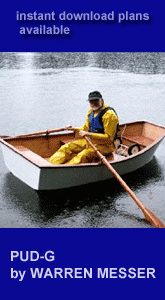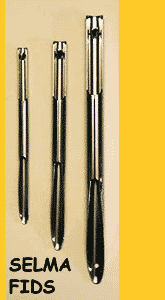
 Custom Search
|
| boat plans |
| canoe/kayak |
| electrical |
| epoxy/supplies |
| fasteners |
| gear |
| gift certificates |
| hardware |
| hatches/deckplates |
| media |
| paint/varnish |
| rope/line |
| rowing/sculling |
| sailmaking |
| sails |
| tools |
| join |
| home |
| indexes |
| classifieds |
| calendar |
| archives |
| about |
| links |
| Join Duckworks Get free newsletter CLICK HERE |
|
|
| August Splash |
Merlin YawlI named the design the Merlin Yawl. Its a 17.5' double ender with a "yawl" rig with a gaff mainsail of 109 sq ft and a standing lug mizzen of only 22 sq ft. Its a synergy of a nomans land boat and a peapod. The boat was designed by Kees Prins and myself during the winter of 2012 while I was attending the great lakes boatbuilding school in Cedarville Michigan. Kees was a guest instructor that year and I just had to take advantage of being in the company of such a talented guy and I broached the topic of designing a small boat for me and presented him with a very thorough design brief. He was interested, saying that this was just the sort of boat he needed in his portfolio and so we began the back and forth of discussing what was wanted versus what was needed. Its really more of a Nomans Land boat than a peapod but with just enough of the peapod in there to allow for oar power to be more of an option than with the NMLB found in Chappelle's book from which we took our two samples to blend. The sections were messaged to give a finer entry and exit through the water but still retain the features to produce a fine sailing craft. Length was shortened, depth was kept about the same and beam narrowed a bit. I had to fight Kees a bit for the rig I wanted but in the end even he agreed that it was the rig that was meant for this hull and that it just looked right, and, that it should perform well for me. There is obviously room for more sail area, much more, but I am a novice, more a neophyte, sailor and this is enough for me for now.
Construction was of the more modern type, glued lap. Planking is 3/8" meranti as is the flat plank keel which is 1 1/2" thick, to allow for easier installation of the centerboard case. Stem and sternpost is laminated Angelique and pretty much everything else is Honduras Mahogany, thwarts, rub rails, inwales, frames are laminated H. Mahogany, hatch frames etc... The mast is on a tabernacle which is all Iroko. The mast itself, and all other spars are CVG douglas fir. The main mast is of birdsmouth construction and all the others are solid. The rudder is quarter sawn white oak. Floorboards are sasafrass. For the finish I went with Fine Paints of Europe's Hollandlac, the best paint ever made in my book. The coverage is outstanding and the colors vibrant. I just love that paint, everything about it. The topsides was done up in a green/grey very close to Kirby's and the sheerstrake an off white with a grey mist for the interior. I should have went with something a little darker for the interior but Im sure it will all need repainted at some point and I will take care of it then. For the bottom I used epoxy with a very, very, very fine copper powder mixed n which I got from Paul Oman. My sails aren't done yet but will be within the next few weeks so Im still trying to finish up all of the little details which consume so much time and get ready to figure out the rigging details. My sails are made from Oceanus 5.5oz sailcloth which should look oh-so beautiful on this hull, with as many hand sewn details as my sailmaker can manage. I want them to look pretty traditional. Hopefully, at some point I will have time to make all of my own blocks and other items which Ive had to buy to complete the look. The boat was featured in Boat Design Quarterly No.44. Mike O'Brien gave her a favorable review saying she should do very well here on the Chesapeake Bay. GIS
GIS has hit the water. MIK Storer ECO 75He made it, the ECO 75 floats and sails now. See article at JUNE REPORTS "first ECO 75". This is a day charter version by the way. The boat was "splashed" some weeks ago. But first it must be moved to the water front. The photo shows the situation. The have had to bring the boat down, height difference 40 m (about 130 ft), to the water front. His neighbors where declaring him for mad. The boat was "splashed" some weeks ago. But first it must be moved to the water front.
The situation.
A critical point. Watch the PVC tubes and slope angle. Everything went fine with a lot of work as you can imagen.
Start of the operation. Look at the PVC tubes.
The morning of the "splash".
Ready for the "splash".
At last afloat. A well deserved beer after all the work. By the way this is in the front cockpit.
Nice setting.
A happy man and his boat
A happy man and his boat I think this photos speak for them self. Happy sailing. Here the first impressions, wording by the happy owner. This is a translation from French by me: The boat performs well at sea little effect "rocking chair" your concept of the concave on the front works, Congratulations! The most conclusive experience was between Tahiti or Moorea at the Venus tip. I followed a Hawaiian canoe race (sailing and paddles outrigger canoes). We had cross winds between 20 to 25 knots with a very confused sea in the channel. We followed the canoes on all courses (upwind and downwind). The boat was going well. We could easily hold there speed which was between 10 and 15 knots. The propellers have the wrong pitch. Speed now is 20 knots (iPad). I expect more when the new propellers are mounted. Currently full speed 5000 rpm range is between 5250 to 6250 revolution. So new propellers should give at approximately 5800 rpm more speed. Consumption: between 3 to 4 liters per engine to a speed of (average)15 knots. Traveling speed 8 knots 1.5 liter per engine. Bernd Kohler Russki
Twelve year old Zach Childs launched his Michael Storer Russki he recently built at Farley Boat Works in Port Aransas, TX. Boat Works manager Frank Coletta prepared a kit and it took about 10 days for Zach to build with a little help from Frank. Zach's sister did the artwork. The boat appears to be versatile. Farley Boat Works is striving to interest young people in boat building. Frank Coletta www.facebook.com/FarleyBoatWorks Pacific Troller DoryI got Lark out on the water in early July.
The hull is from plans by Paul Butler - his Pacific Troller Dory - I just call it a gunning dory. 15 foot long, 4 foot beam. Stitch and glue. I added the sailing bits to the plan myself. The rig is a lateen sail and spars from an Old Town canoe that I picked up for $20. She rows and sails great. The boat is light enough that I can launch it from a dolly at my local beach. It will be used for fishing and sailing and rowing fun on Lake Erie. And she is light enough to be hauled cartop style on top of our popup camper when we go camping. I have yet to try the trolling motor on her, but I think she will do just fine with the little electric motor on there too. Tim Abbott Summer Breeze at the Start
La Madrugada is done! (Spanish for day spring.) About 3 years in the making. My first boat! It started out as the Summer breeze one sheet. Got tweeked a little here and there. Air tight compartments fore and aft. Roland my 14 year old copilot didn't like the lee board so I did a side dagger board. Covered with tb2 and fabric Poly tarp sail from a Polysail kit. Roland says I need a bigger boat. He'll help me make it. Then he keeps this one... Lynn The Blue CanoeGot the canoe project on the water today. No real problems other than not knowing how to use a kayak paddle. Ian Stella MarisI finally launched "Stella Maris" on 24 June, 2015, about 12 years after ordering the plans. Mind you, I also built 4 other boats in the same time period, and my excuse for taking so long is that that Canadian winters allow only about 6 months of building time every year in an unheated garage.
Stella Maris sails beautifully, and draws comments from other sailing club members all the time. Thanks for the lovely design. Hope to get some photos of her under sail before too long. Still learning all the ropes - it's a bit different from sailing my Dufour 25', which I enjoyed for the past 15 years. Jonas Re-Launching of a Sailing CanoeWe're out on the water and enjoying life with our sailing canoe! I used to have a very small canoe company back in the 90s. This canoe was stored outdoors for 15 years by one of my customers. This past winter, I restored it (with the help of Duckworks) and added a sail rig and rudder. It was a great project and we really have fun sailing her. Bob Guide BoatAlong with Pat Brown and Steve Kaulback, Mark Anderson is one of a select group of truly talented Adirondack Guide Boat designers and builders here in the Northeast. The boat weighs 49 lbs. Here are photos of his latest design. It is his first departure from woodstrip construction. Rob Guenther has raced guide boat's in all types of venues and conditions. If he's impressed, the boat has to be good! Gerhard Munger is an oarsman of similar caliber in guide boat circles and gives it a strong thumbs up as well. I'd suggest a look at his website www.oarsmanboats.com A significant contribution on his part are his competition - grade stainless steel guide boat oarlocks and straps - perform silken smoothly and and are extraordinarily durable. Rodger |
 |




































